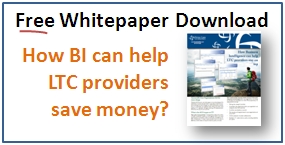 Leaders who are really successful are those who are accountable and hold others accountable. Over the years I have served in several leadership positions in this amazing industry/profession, we call Long Term Care, and have observed many who live the principle of accountability. The more precise the terms of the accountability, the more effective the leader and the team he or she leads. You may think it odd that in a technology blog, you would read about leadership, but be patient. There is an IT-related point to this.
Leaders who are really successful are those who are accountable and hold others accountable. Over the years I have served in several leadership positions in this amazing industry/profession, we call Long Term Care, and have observed many who live the principle of accountability. The more precise the terms of the accountability, the more effective the leader and the team he or she leads. You may think it odd that in a technology blog, you would read about leadership, but be patient. There is an IT-related point to this.
Accountability starts from within; it is a state of mind – a conduct-determining constant. It is the leader’s willingness to be responsible for his or her own actions and the actions of those who report to him or her. Merriam-Webster defines accountability as “an obligation or willingness to accept responsibility or to account for one's actions.” How does one measure “one’s actions?” How accurate are those measurements? How often should one be held accountable?
 Rendering an accounting has been a periodic, often formal event. But the nature of that “rendering” has changed. In the past, when all things were paper based, either the leader prepared or relied on someone else to prepare documentation/reports targeting specific responsibilities – a time-consuming and laborious process. What’s more, it was very much after the fact. As I sat in on monthly P&L reviews or periodic performance reviews, the matters discussed were usually a “day late and a dollar short.” I like the adage that I heard Dr. Wayne Dyer once cite, “I can’t should’ve anything.”
Rendering an accounting has been a periodic, often formal event. But the nature of that “rendering” has changed. In the past, when all things were paper based, either the leader prepared or relied on someone else to prepare documentation/reports targeting specific responsibilities – a time-consuming and laborious process. What’s more, it was very much after the fact. As I sat in on monthly P&L reviews or periodic performance reviews, the matters discussed were usually a “day late and a dollar short.” I like the adage that I heard Dr. Wayne Dyer once cite, “I can’t should’ve anything.”
Well, fortunately for those who possess an “accountable” paradigm (and, yes, I am finally making my point), IT has streamlined accountability and the its rendering process; at the click of a button it is current, up to date. With Business Intelligence (BI) and data mining, leaders have real-time access to their Key Performance Indicators (KPIs) for which they are accountable. No longer do they need to prepare reports. No longer are there managers working blind and needing to set, and harangue their subordinates about, deadlines for reports submissions. In real time, leaders and their managers can view what is going on. If the data exists, digital dashboards can display. Senior management can view these KPIs at a high level or drill down to the operational unit level. Local leaders can also use the dashboards to refocus on that which matters most. Leaders do not have to wait for reports or try to guess how they are doing. BI is actionable, because it’s current and displayed in terms that are useful, which is what accountable leaders hunger for. “Feedback is (indeed) the breakfast of champions.”
From a more global standpoint, embedded in the heart of the whole Accountable Care Organization momentum is accountability. More immediately, as LTC leaders have recently pointed out, only providers who can render an accounting and demonstrate that they can help hospitals meet their regulated readmission constraints will get the referral business.
I don’t know about you, but I’m on board with the idea that real-time business intelligence is a key to effective accountability. In today’s world, accountability – it’s more than just a mindset; it’s a must; it’s reality.
/Prime-Care-Technologies-Logo.png?width=191&height=55&name=Prime-Care-Technologies-Logo.png)



 Over the last several months, this blog has covered topics focusing on various aspects of IT and its impact on long term care. In our
Over the last several months, this blog has covered topics focusing on various aspects of IT and its impact on long term care. In our  In the Spring of this year, I used baseball as a metaphor for the “
In the Spring of this year, I used baseball as a metaphor for the “ Introduction
Introduction